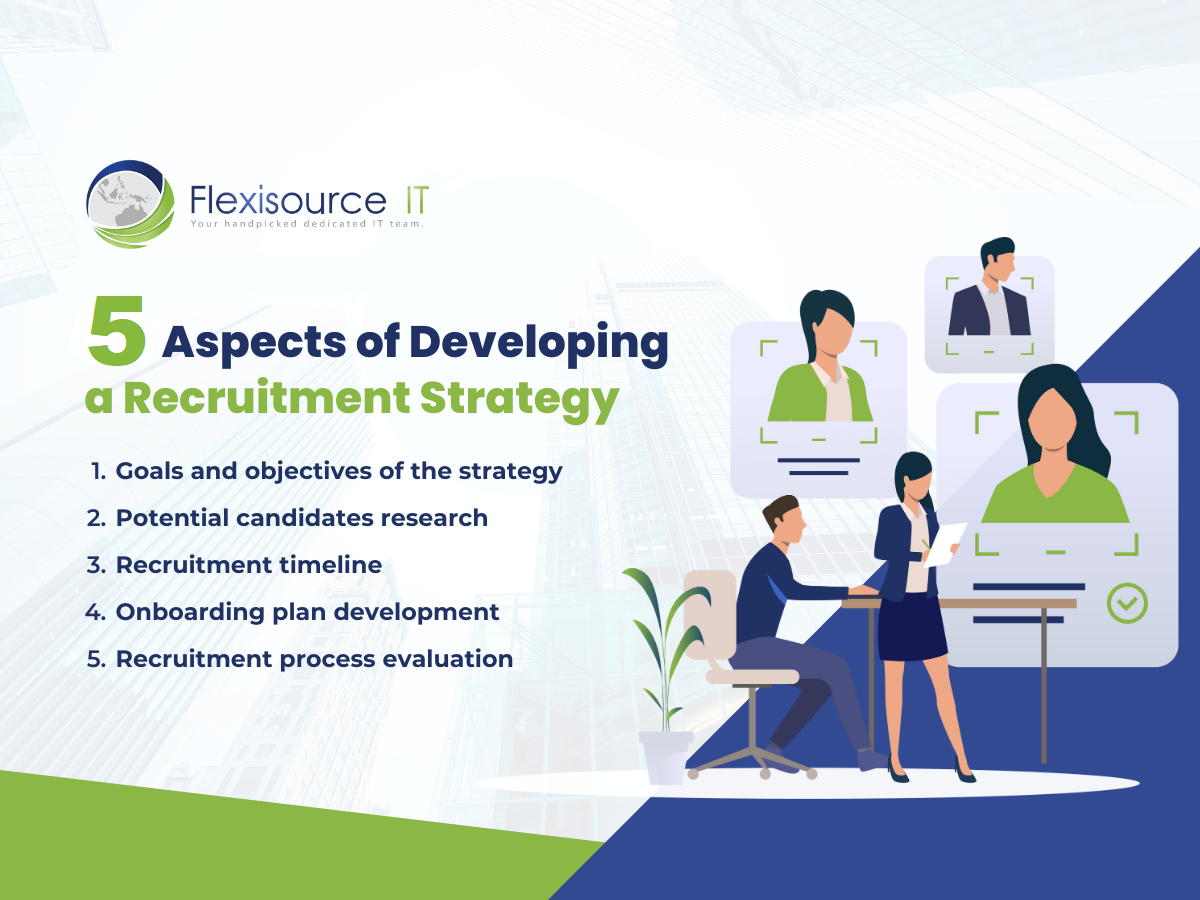Employees and people are the backbones of any successful company. Without its employees’ dedication, hard work, and commitment, a business will never reach its full potential. Employees are the ones who make a company’s vision come to life and help it grow and succeed. Moreover, they provide stability and direction for future growth.
That is why recruiting talent is probably one of the most crucial aspects of any successful organisation. However, finding the right candidate can be challenging and time-consuming. In addition, you need to have the ability to attract and retain talented employees who share your vision and values.
This article will explore the out-of-the-box recruiting strategies companies can use to improve their hiring process and ensure they make the best hiring decisions. By implementing these strategies, companies can enhance recruitment efforts and build a talented and diverse workforce that drives business success.
Table of Contents
What is a recruitment strategy, and why is it important?
A recruitment strategy is an integral part of any organisation’s success. It involves planning, identifying, and selecting the best talent to fill positions in the company. It also involves creating a plan to attract, retain, and develop employees to ensure organisational performance.
Companies use recruitment strategies to identify and hire people with the right skills and experience for their roles. This helps them build an ardent team of professionals to help their organisation reach its goals. Recruitment strategies are essential for businesses as they provide a competitive edge in today’s highly competitive market.
What are the aspects of developing a recruitment strategy?
Developing a recruitment strategy is essential for any organisation looking to hire the best talent. It helps you define the goals and objectives of your recruitment process, identify fit candidates, and create an effective onboarding plan.
To develop an effective recruitment strategy, five key aspects need to be taken into consideration:

1. Defining the goals and objectives of the strategy
Having a clear recruitment strategy is essential for any business. Defining goals and objectives is vital to hire the right people for the right roles. By setting measurable goals and objectives, companies can ensure they recruit suitable candidates to help them reach their desired target.
Additionally, having a well-defined recruitment strategy helps businesses save time and money by eliminating unnecessary interviews and screening processes.
2. Researching potential candidates
Researching potential candidates is a crucial recruitment strategy that can help companies identify top talent and make more informed hiring decisions. Employers can get an idea of their qualifications, experience, and skill sets to ensure they make the best hiring decision. Additionally, research can help employers identify any red flags before committing to a hire.
Likewise, here are some steps to consider:
- Choose your ideal candidate. Develop a clear understanding of the skills, experience, and qualifications you are looking for in a candidate. This will help you to focus your research efforts and identify the most relevant sources of information.
- Use online platforms. Social media platforms such as Twitter, LinkedIn, and Facebook can be valuable sources of information about potential candidates.
- Review their resume, application letters, and other documents. Carefully review the resumes and cover letters of candidates who have applied to your job postings. Look for indications of relevant experience, education, and skills.
- Conduct phone screens. Phone interviews with potential candidates can help you better understand their qualifications and experience.
- Conduct reference checks. Contact the candidate’s references to verify their employment history, skills, and experience.
3. Creating a recruitment timeline
The recruitment timeline is an essential factor in a recruitment strategy. It sets a clear expectation for both the employer and the candidate. It helps ensure that the recruitment process runs smoothly. Having a clear timeline makes employers confident when making informed decisions based on accurate information.
In addition, a well-defined recruitment timeline can help reduce time-to-hire and ensure the right candidate is chosen for the job. It also helps keep communication between all parties involved in the recruitment process organised, making it easier to track progress and identify potential issues.
4. Developing an onboarding plan
Onboarding is a vital phase in the recruitment process, and it is essential to have a well-defined onboarding plan. It helps set expectations for the candidate and the organisation. Likewise, it ensures that new employees are integrated into their roles quickly and seamlessly.
An effective onboarding plan can help new hires understand their job responsibilities, build relationships with colleagues, and become productive team members faster. Likewise, a good onboarding plan reduces turnover rates and increases employee engagement.
5. Evaluating the results of the recruitment process
Evaluating the results of a recruitment process is critical to understanding how effective it has been. This evaluation should include an analysis of how well candidates were selected, what criteria were used in making hiring decisions, and whether each candidate met those criteria.
Additionally, evaluating the results of a recruitment process can provide insight into areas for improvement, such as better targeting potential candidates or streamlining processes for future recruitments.
5 Best Strategy for Recruitment
After preparing all the essential aspects of recruitment, it is time to create your strategy. Here are some top hiring strategies you should implement in your company.

1. Identify Job Requirements and Target Candidates
Finding the right applicant for a job can be difficult and time-consuming. That is why employers must define job requirements clearly and identify target candidates that meet those requirements.
By defining job requirements clearly, employers can determine which candidates are most likely to succeed in the role, helping them find the best fit for their organisation. In addition, it will help employers narrow their search and make recruitment more efficient.
Furthermore, identifying target candidates helps employers save time by focusing on those who meet their criteria and avoiding those who do not. This allows them to quickly move forward with their recruitment process and get started on finding their ideal candidate sooner rather than later.
Here are some ways you can target ideal candidates:
- Creating a detailed job description
- Defining essential qualifications and skills
- Utilising candidate personas
2. Leveraging Employer Branding
Employer branding is a powerful way for companies to attract top talent. It creates an attractive image of the company, its culture, and its employees.
Employer branding is essential because it helps companies stand out from their competitors and build a positive reputation in the market. In addition, it allows companies to create an environment where employees feel valued and appreciated, which leads to greater job satisfaction and loyalty.
Building a strong employer brand requires understanding your target audience and how you want to be perceived. Employers must do the following:
- Create content that resonates with potential employees.
- Develop authentic employer value proposition (EVP)
- Leverage social media platforms to engage with job seekers.
- Optimise your recruitment process.
3. Utilising Recruitment Marketing
Recruitment marketing is one of the best recruitment strategies in the industry. It helps attract, engage, and retain top talent. Recruitment strategy involves creating a positive image of the company and its culture. This ensures that job seekers understand what they can expect from the role they are applying for.
Recruitment marketing requires a strategic approach to attract suitable candidates to your job openings. Here are some steps to consider:
- Develop your employer brand. Develop a clear employer brand that communicates your company’s values, culture, and mission. This can help you to attract candidates who share your values and are passionate about your company’s mission.
- Leverage social media. Use social media platforms like LinkedIn, Twitter, and Facebook to promote job openings and build your employer brand. Post regular updates about your company culture, team events, and job openings to engage potential candidates.
- Invest in targeted advertising. Consider investing in targeted advertising on social media platforms and search engines to reach potential candidates actively searching for jobs.
- Attend recruiting events. Attending industry and recruiting events can help you personally connect with potential candidates. This can be a fantastic way to build relationships with potential hires and promote your employer brand.
4. Implementing Employee Referral Programs
An employee referral program is an effective recruitment strategy to attract and retain new talent and build a formidable team. Likewise, employee referral programs can provide numerous benefits for businesses.
- Companies can source high-quality candidates quickly and efficiently by encouraging existing employees to refer potential candidates.
- They can help reduce recruitment costs, increase the quality of hires, and promote a positive company culture.
- Companies can reach a larger pool of potential candidates through current employees’ networks.
- By relying on current employees’ recommendations, companies can ensure that they are making informed decisions when hiring fresh staff members.
5. Utilising Data and Analytics
Data and analytics play an essential role in recruitment. With the help of data and analytics, recruiters can make informed decisions when hiring new employees. They can analyse the data to identify potential candidates with the skills and experience needed for a particular role.
Likewise, data and analytics can be used to evaluate job candidates, measure performance, track employee engagement, and develop effective recruitment strategies. There are numerous ways to set up a referral program for recruitment. Here are some ideas to consider:
- Offer cash rewards. The amount of compensation can vary depending on the role and level of the position.
- Provide non-cash incentives. Some companies offer non-cash incentives such as gift cards, extra vacation days, or company swag to motivate employees to make referrals.
- Create a leader board. This can help create friendly competition and encourage employees to participate in the program.
- Use gamification. Gamification techniques such as badges or points can encourage employee participation in the program. Employees can earn rewards for achieving certain milestones or referring a certain number of candidates.
- Create a referral portal. Build a dedicated referral portal on your company’s career site where employees can submit referrals and track their progress. This can streamline the referral process and make participating easier for employees.
Conclusion
In conclusion, hiring the right talent is essential for the success of any organisation, and implementing effective recruitment strategies can make a significant impact. Companies can attract a pool of qualified candidates by developing a strong employer brand, creating compelling job descriptions, leveraging social media, and optimising the application process.
Additionally, employee referrals, recruiting events, and targeted advertising can help reach potential candidates that might not be actively looking for a job. Finally, investing in diversity and inclusion initiatives can help create a more inclusive workplace and attract diverse candidates.
By incorporating these top recruitment strategies, companies can streamline their hiring process, attract top talent, and build a dedicated team for the future. And if you need an opinion of an expert, contact Flexisource IT! We recruit top IT talents in the Philippines. Contact us now!
Pamela is a full-time content writer and a lifelong Philomath. Her previous experience as a research analyst made her passionate about traveling the world and understanding how it works. During her day off, you can often find her indoors, writing stories or oil painting.


